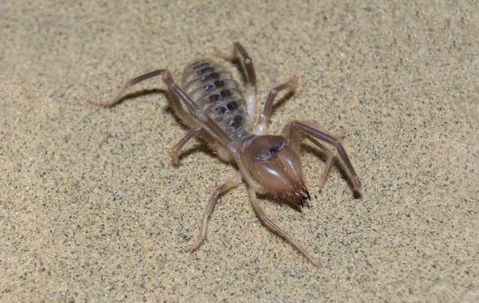Camel spiders, also known as solifuges or wind scorpions, are not actually spiders, and their venom is not considered dangerous to humans. While they are capable of delivering a painful bite, their venom is primarily used to immobilize prey, such as insects and small animals, rather than for self-defense against larger animals like humans. These creatures are found in arid regions, primarily in deserts, and are known for their speed and aggressive hunting behavior.
While the bite of a camel spider can be painful and might cause localized swelling or irritation, it is generally not considered medically significant, and severe reactions or long-lasting effects are rare. Most cases of camel spider bites can be treated with basic first-aid measures, such as cleaning the wound, applying an antiseptic, and using pain relief as needed.
Are Camel Spiders Venomous?
No, camel spiders (Solifugae) are not venomous. They belong to the arachnid class but are neither true spiders nor scorpions. Instead of venom, they rely on their powerful chelicerae (jaws) to crush and tear their prey. Although their bites can be painful due to their strong pincers, they do not inject venom and are not medically dangerous to humans.
Camel spiders are often the subject of myths and exaggerated stories, which have led to their reputation as highly venomous and dangerous creatures. In reality, they are not a significant threat to humans, and there is no need for excessive concern if you encounter one.
Camel Spider Bites
Camel spider bites typically appear as red, swollen, and painful areas on the skin. The specific appearance of a camel spider bite can vary depending on the individual's reaction and the circumstances of the bite. Here's a more detailed description of what camel spider bites may look like:
Redness: The area around the bite site often becomes red and inflamed. This redness is a common sign of an inflammatory response to the venom injected by the camel spider.
Swelling: Swelling is another common symptom. The bite area may become noticeably swollen, and the degree of swelling can vary from person to person.
Pain: Camel spider bites can be quite painful. The pain is often described as a sharp or burning sensation at the site of the bite.
Itchiness: Some individuals may experience itchiness around the bite area, which can be bothersome.
Blistering: In some cases, a blister may form at the site of the bite. This is more likely to occur if the bite becomes infected or if there's an allergic reaction.
Infection: If the bite is not properly cleaned and treated, there is a risk of infection. Signs of infection may include increased redness, warmth, pus, and worsening pain.
While camel spider bites can be painful and uncomfortable, they are generally not considered medically significant, and serious complications are rare. If you suspect you've been bitten by a camel spider or any other insect or arachnid and experience severe symptoms or signs of infection, it's advisable to seek medical attention promptly. Otherwise, basic first-aid measures such as cleaning the wound, applying an antiseptic, and taking over-the-counter pain relievers can help manage the discomfort associated with the bite.
How To Treat Camel Spider Bites
Treating camel spider bites involves basic first-aid measures to alleviate pain, reduce the risk of infection, and promote healing. Here is a comprehensive guide on how to treat camel spider bites:
Wash Your Hands: Before touching the bite or attempting any treatment, wash your hands thoroughly with soap and water to prevent introducing any potential infection.
Clean the Bite Area: Gently clean the bite area with mild soap and warm water. Use a clean, damp cloth or sterile gauze to remove any dirt, debris, or venom that may be on the skin.
Apply an Antiseptic: After cleaning, apply an over-the-counter antiseptic solution, like hydrogen peroxide or rubbing alcohol, to disinfect the wound. This helps prevent infection.
Elevate and Rest: If the bite is on an extremity (arm or leg), try to keep it elevated to reduce swelling. Resting and avoiding strenuous activity can also help.
Cold Compress: Applying a cold compress or ice pack wrapped in a clean cloth to the bite area for 10-15 minutes at a time can reduce pain and swelling. Be sure to place a barrier, like a cloth, between the ice and your skin to avoid frostbite.
Pain Relief: Over-the-counter pain relievers like ibuprofen or acetaminophen can help alleviate pain and discomfort. Follow the dosing instructions on the medication label.
Keep It Clean and Dry: To prevent infection, keep the bite clean and dry. Avoid picking at the bite or applying adhesive bandages that might trap moisture.
Watch for Signs of Infection: Keep a close eye on the bite site for any signs of infection, such as increasing redness, warmth, pus, or worsening pain. If you suspect an infection, seek medical attention promptly.
Avoid Scratching: It's essential to resist the urge to scratch the bite, as this can introduce bacteria and potentially lead to infection.
Seek Medical Attention if Necessary: While camel spider bites are typically not serious, some individuals may have an allergic reaction or experience more severe symptoms. If you develop severe pain, difficulty breathing, swelling of the face or throat, or any other concerning symptoms, seek immediate medical help.
Remember that most camel spider bites do not result in significant health issues, and they often resolve on their own with basic care. However, it's crucial to monitor the bite site and seek medical attention if you have any doubts or if the symptoms worsen. Additionally, if you are in an area where dangerous spider species are known to be present, and you are uncertain about the source of the bite, it is advisable to seek medical attention as a precaution.

